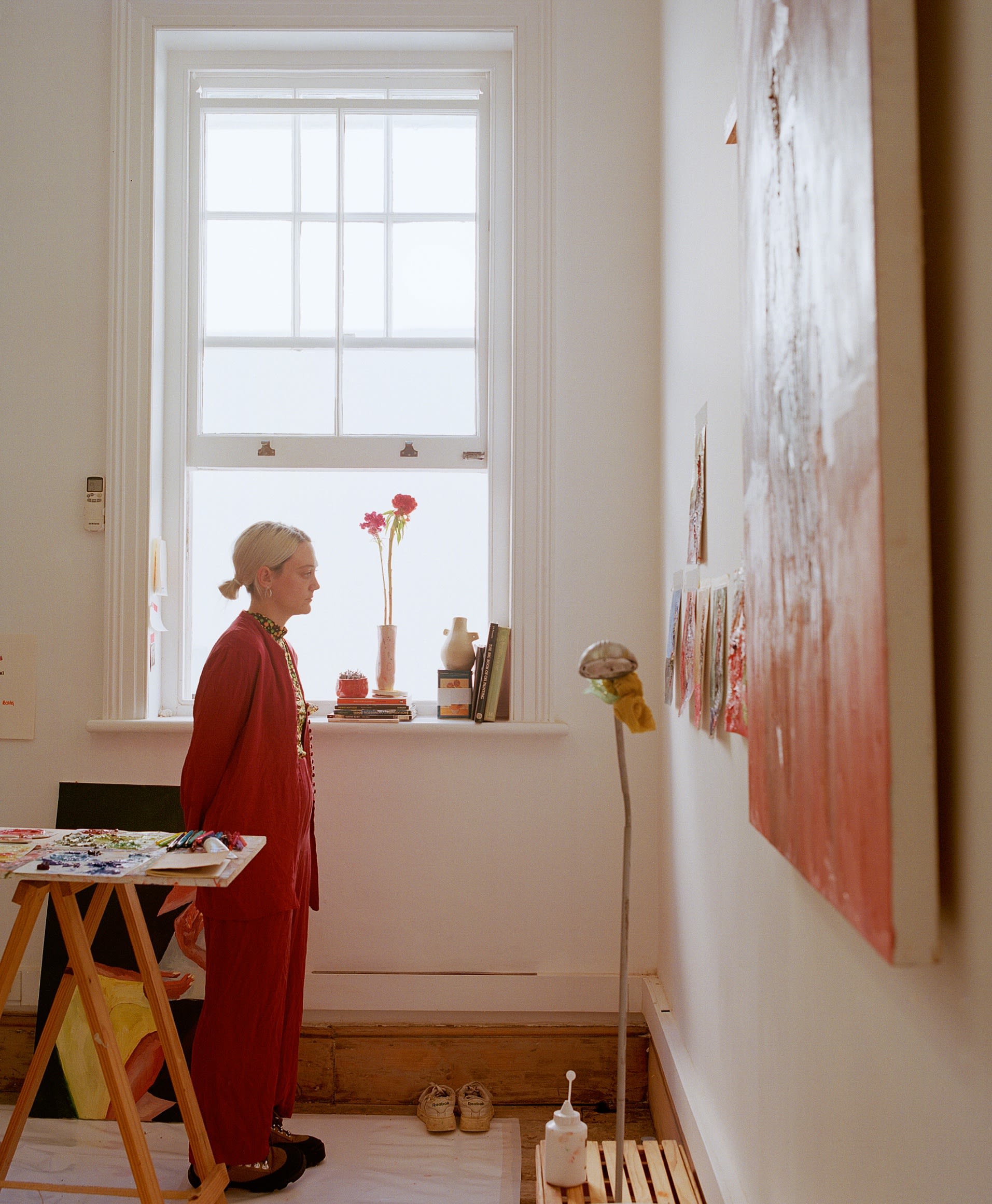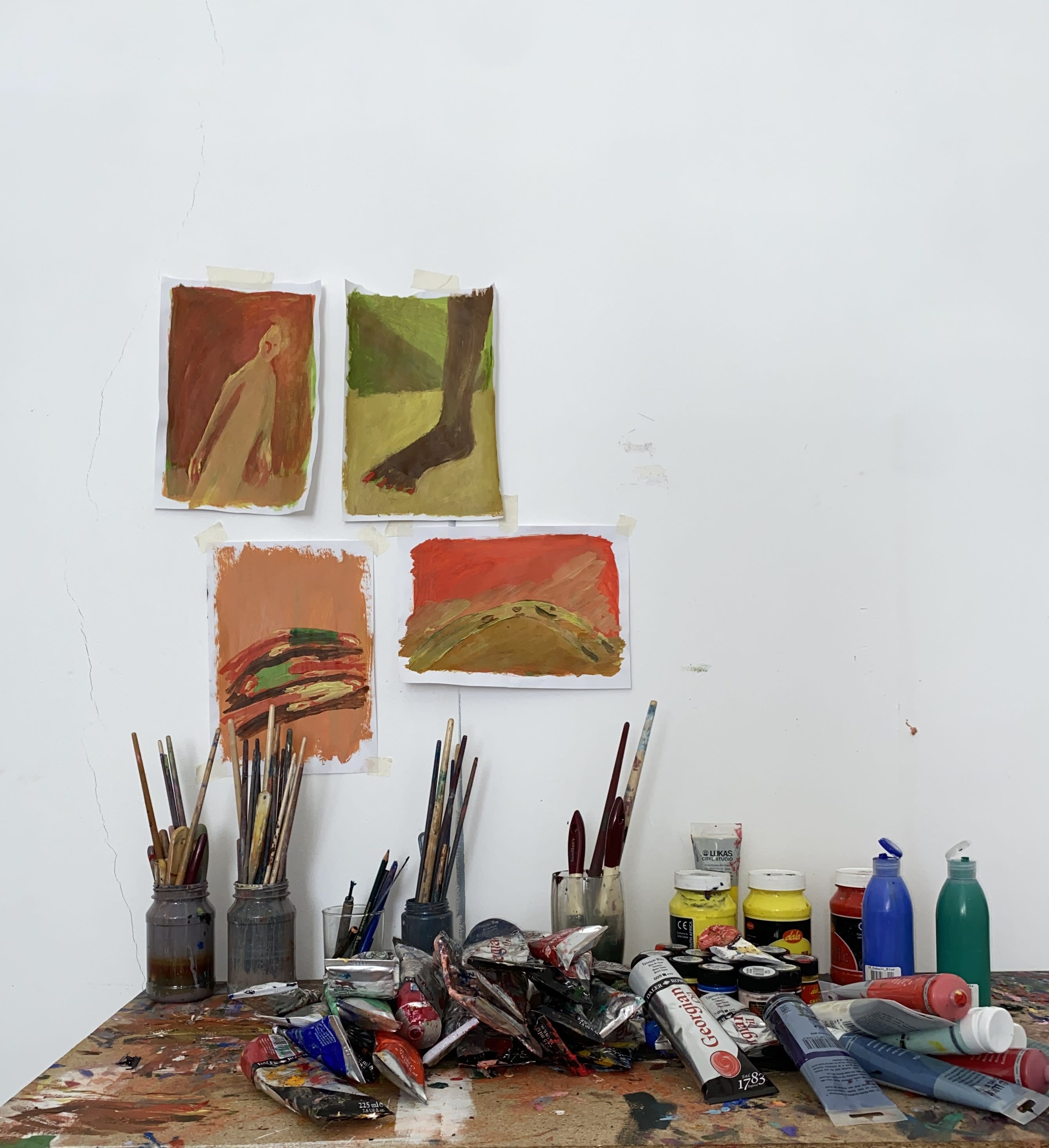
After studying, I didn’t make any work for a year. I took this time to figure out what I wanted to do, perhaps trying something other than making art. Getting back into making work felt very far removed from where I was when I was studying. I didn’t have access to a print studio, or any space to make art, and even thinking about installations felt out of context. Taking that time out was really useful. I started to miss making things and the pressure of making art that would be seen by other people was no longer there. Towards the end of that year I started making small oil paintings and drawings. It felt playful and I felt excited about it. In that way I slowly and almost unintentionally became an oil painter.
The first thing that strikes attention while observing your paintings is definitely colors. You obviously prefer vivid bright colors, sometimes even using color blocking, so that the color itself turns into a kind of protagonist of the painting. Could you please explain to us, what does color mean for you?
Color means a lot. I use color to try and create a mood that can be felt by a viewer, to indicate a feeling or an emotion that is part of the story, that the painting might be trying to tell. I also try and use it in such a way as to help the viewer imagine what might be beyond the borders of the painting - a different world, at a different time. It can both be the protagonist of the painting, but can also set the scene and tell us about the figures or objects. Often painting feels like a series of small decisions, and most of these decisions are deciding what color I want to use and how to make them work with each other. I think color can also just be used to make something look beautiful or ugly. I think both are valuable.
 © Anico Mostert's studio. Image: Kent Andreasen
© Anico Mostert's studio. Image: Kent Andreasen
Another recurring motif of your works are these semi-abstracted mysterious figures, frequently depicted without faces. Who are they? Do they belong to our world or to some other parallel reality?
The figures are often from my internal world, and then the colours that I use are a way to show what that world feels like. Both to them and to me. They are often not a specific person. My intention is more to show their experience of particular moments, and when I paint them I try and imagine how they would feel about what they are experiencing. They are not trying to change their experience; they understand the importance of moving with whatever the moment brings. Their faces melt away because they're being absorbed by another figure, or the environment. This, to me, can both indicate closeness and intimacy or loneliness and wanting to fade or float away. I also want to give the viewer a sense of time. Their bodies are long and lanky to create a sense of a particular moment being stretched and warped. The figures can seem to be climbing inside one another to both become closer to and a part of each other. Sometimes I imagine them to be becoming what they are feeling. In that way, they can be a reflection of their own internal worlds.
One cannot but mention your reference to a Norwegian artist Edvard Munch. Especially one of your latest works – Big Blue – is a clear homage to Munch’s The Kiss. Could you comment on this?
That was not intentional, but I love that painting. So it’s very possible that it was floating around in my subconscious, while I was working on Big Blue. I think that this happens often and is something that I love about painting.
Your paintings convey the idea of spontaneity and quickness, creating a fleeting moment. Does it resonate with the way how your practice looks like? Do you work with sketches, elaborating your ideas before, or rather go directly to the canvas and immediately start painting?
Yes, it does. Once I know what I’m doing and feel confident in that, I work quite quickly. But deciding what the painting needs and finding that confidence - knowing that what you do next might throw the painting off or take it in another direction - can sometimes take a bit of time. I like making quick sketches and often do a lot of small paintings on paper that I refer back to when working on bigger works. Although I often just go for it and see what happens along the way. Moving between these two modes has a lot to do with how I’m feeling when I’m in the studio on a particular day.

© Anico Mostert's studio. Image: Anico Mostert
Your works are very strong emotionally – each of them translates a strong feeling to the outer world – ranging from incredible joy to deep sadness. Do they reflect your inner emotional state at the moment of creating a work?
Absolutely. I can feel overwhelmed emotionally and putting that on canvas is a way for me to place that outside of myself and my mind. There is often something quite specific that I’m thinking about when I’m painting, but I never want to be too explicit or share too much of that, because I want my work to be understood from the viewer’s point of view. I give some indication as to what the work is about, but I feel that the viewer can fill in the blanks with what they need to.
You also use images from social media as references. Do you get inspiration from this digital world or rather being ironic about it? Perhaps both?
I accumulate images from social media, photos that I take, and photos that my friends have taken. These can all provide inspiration for me. Over time I’ve built up a library of images that I can collage together to create my own images.
Last year you were invited to participate at JO-HS residency program in Mexico City. How has this experience influenced your art practice?
This was my first residency and it was amazing to see how a change of environment changed the way that I work, and especially how I use colour. I was there for around three weeks and I think the limited time in a very exciting city made me approach painting in a new way. I was often by myself, and navigating through a city where I don’t speak the language was sometimes tricky. The paintings that I made at times felt chaotic and confusing, but I didn’t necessarily mind that. It was nice to see how much of my experience was being reflected in what I was painting and how I was painting. I always used to struggle to work with blue but for some reason after going to Mexico, I now use it a lot more. I can’t quite explain this but maybe it was going to Frida’s house that helped me make the switch. I experienced the city as a very joyful place and it was interesting to feel that but to also experience loneliness and overwhelm at the same time, and I think this can perhaps be seen in the work that I made when I was there.
 © Anico Mostert's studio. Image: Anico Mostert
© Anico Mostert's studio. Image: Anico Mostert
Your latest works, Raft and Trying to be a Circle, presented in Berlin with BODE, tend to be more abstract. Do you see your practice moving to abstraction or was it just a one-time experiment?
Both of those paintings started as exercises that I was doing using acrylic and paper. The intention there was to just paint from my imagination and not spend too much time with each piece of paper. I sometimes try to do exercises like this in the studio to remind myself that I don’t always have to be too precious about what I make and that playing and experimenting can always help to inform larger and more intentional paintings. I made around 20 of these quick drawings and paintings and am still using some of them for larger paintings that I’m working on at the moment.
You live and work in Cape Town. How do you find the local art scene? Do you feel yourself as a part of it? Do you have strong connections with Cape Town’s art community?
My studio is around 40 kilometres away from the Cape Town city centre in a small town called Simon’s Town, so during the week I am often quite far away from the gallery openings and other art scene events that are happening in and around the city. However, I do have a lot of friends that are also artists and there are 10 other studios’ in my building so that helps me to not feel too far away from the art scene.
Could you please tell us a bit, what you are currently working on and give a quick glance into the future. Do you have any extraordinary idea in your mind, not necessarily related to art, that you would like to bring into life one day?
I’ve been reflecting on the installations that I made for my final exhibition when I was studying quite a bit lately, and how I could incorporate that way of thinking into the art that I’m currently making. I’m not sure what it would look like yet but it’s something that I’m actively trying to figure out in the studio.
Interview conducted by Valentina Plotnikova